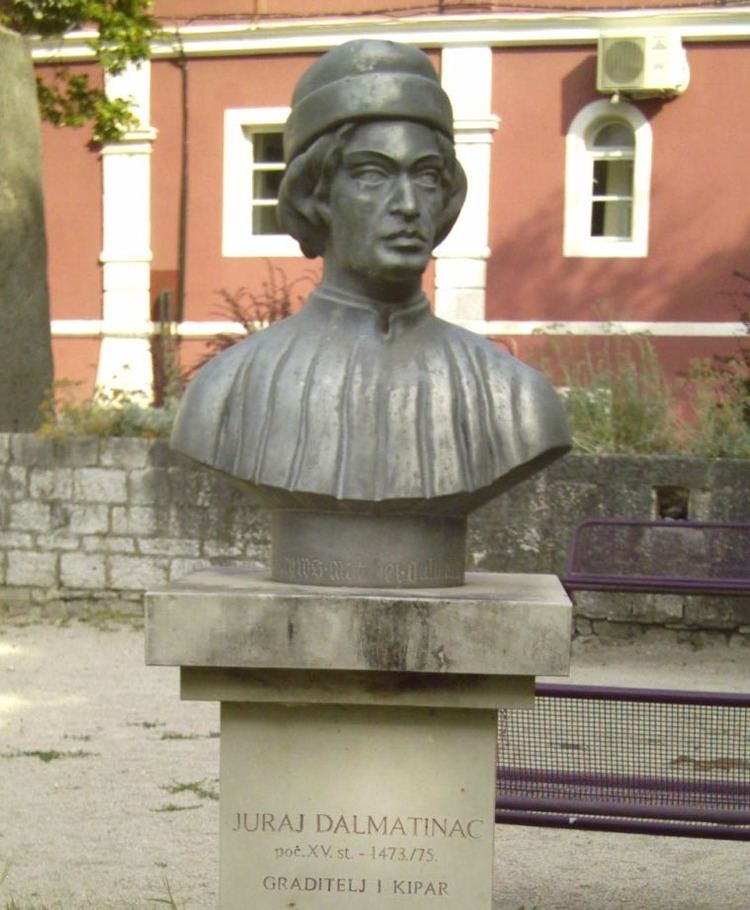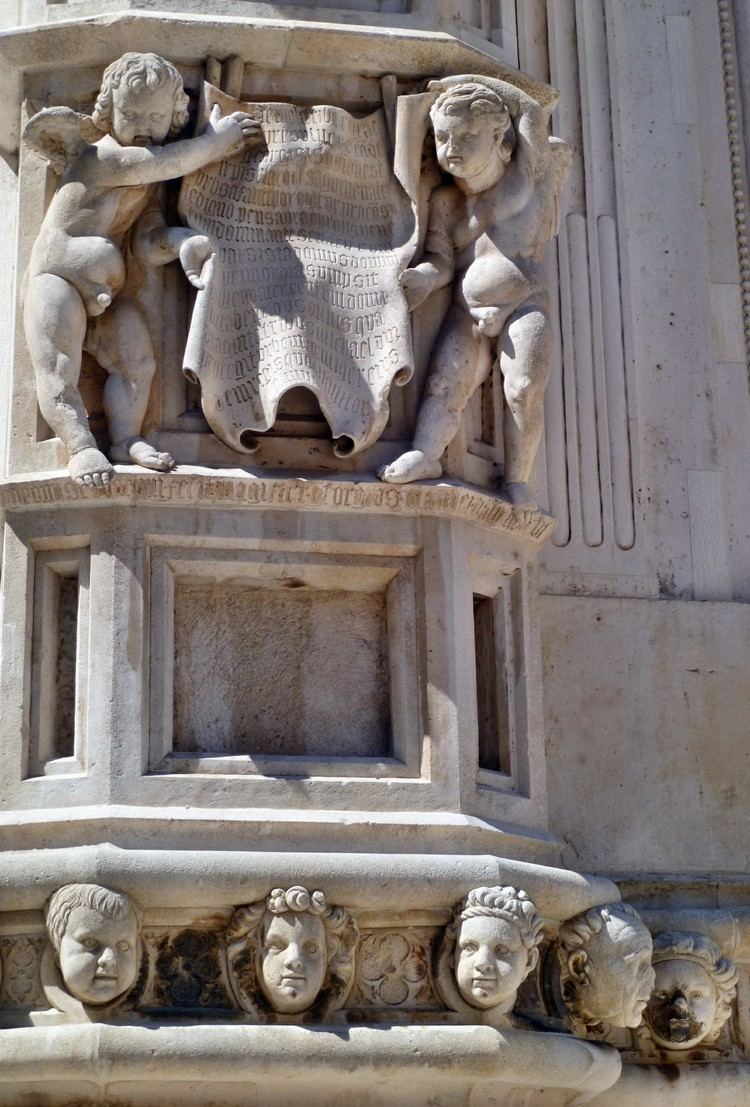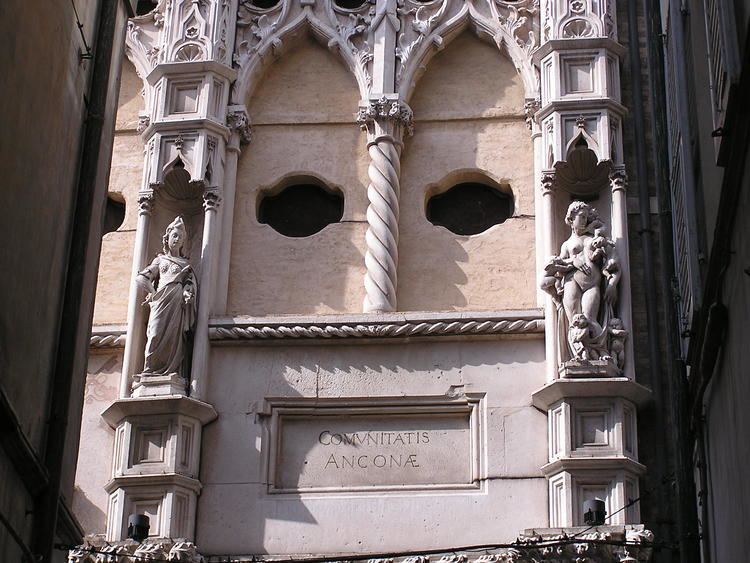Marriage location Venice, Italy Spouse Elisabetta Da Monte | Role Architect Name Giorgio Sebenico | |
 | ||
Died October 10, 1473, Sibenik, Croatia | ||
Giorgio da Sebenico (Croatian: Juraj Dalmatinac; c. 1410 – 10 October 1473) was a Venetian sculptor and architect from Venetian Dalmatia, who worked mainly in Sebenico (now Šibenik, Croatia), and in the city of Ancona, then a maritime republic.
Contents

Life

Giorgio da Sebenico was born in the Dalmatian city of Zara (now Zadar, Croatia), which was part of the Republic of Venice (see Venetian Dalmatia).
He emigrated to Venice during his youth, where he was probably trained as a sculptor in the workshop of Giovanni and Bartolomeo Bon, or at least worked with them as an independent associate. He would not have been awarded the great responsibility of the 1441 Šibenik contract without having experience of major works, and various attributions of surviving sculptures in Venice to him, as part of the Bon workshop, have been made, including the decorations on the Porta della Carta of the Doge's Palace. Anne Markham Schultz dismisses all previous suggestions as stylistically incompatible, but instead proposes the relief of Saint Mark enthroned among members of the Confraternity of Saint Mark in the lunette above the main entrance to the Scuola di San Marco, which she dates to 1437-1438 and finds close in style to Giorgio's later works at Šibenik and elsewhere. As his style here has few similarities to other works by the Bons, she considers it most likely that he worked with them when already a master, who had trained elsewhere. She believes his personal style offers few clues as to where this might have been.
In 1441, when still resident in Venice, Giorgio was summoned to Šibenik in order to take charge of the construction of the Cathedral of St. James. He moved by the end of August, under the condition set in the contract with the procurators of the Cathedral to take up residence there for six years. On 1 September 1446 he agreed to extend his contract as chief architect for another ten years. Giorgio was granted permission to remain in Venice for two months every two years on condition that he did no work there except on his own house. He will work on the Cathedral from 1441 till 1473, although discontinuously because the work were interrupted several times for lack of funds and probably for a fire.
In Venice he married Elisabetta Da Monte (daughter of Gregorio da Monte, a Venetian carpenter), who brought him as her dowry some houses in Venice. After 1450 he worked in both Ancona and Sebenico, with a period in Dubrovnik between June 1464 and November 1465, mostly working on the fortifications. He travelled to Rome in 1470-71. He is believed to have died in Sebenico on 10 October 1473.
Work
His work represents the golden age of Dalmatian medieval art. He was one of main artists of the Adriatic Renaissance, a tendency widespread during the late 15th century in Venice, Dalmatia and in some locations of the Italian Adriatic Coast, such as Ancona. According to Stanko Kokole, "Although his style was firmly based on the Venetian Late Gothic tradition, Giorgio was fascinated by the Florentine Renaissance, the influence of which is apparent in his figure sculptures." Influences and borrowings from many Florentine sculptors including Donatello, Ghiberti, Luca della Robbia, Niccolò Pizzolo, Antonio del Pollaiuolo, and Jacopo della Quercia can be detected in various works.
His most beautiful achievement remains the Cathedral of St. James in Šibenik for which he was a chief architect from 1441 till 1473. The entire building was built solely of limestone from Istria, with no wood or bricks used in the structure. The building presents all along the perimeter a hedge composed of 72 stone-carved heads. On top of this hedge, and precisely on the North side, Giorgio added two angels; at the base of this work the artist engraved his signature. The task before him was to build the choir, of which foundations had not been laid, to raise and roof the nave which was only completed to the top of the aisle vaults, and to covering the crossing by a lantern or cupola. Unfortuately lack of funding and a fire delayed the achievement of the construction. From 1 July 1477 the work on the Cathedral of St. James was continued by an architect from Tuscany, Niccolò di Giovanni Fiorentino.
In Split he built several palaces. In 1448 he carved a stone altar in the Cathedral of Saint Domnius, with a remarkable representation of the flagellation of Christ. In Dubrovnik he helped repairing the Duke's Palace and helped building the Minčeta fortress in 1464 and 1465. He also made an urban plan for Pag and contributed to the project and construction of Pelješac walls. He was at the same time sculptor, architect and urban planner, showing in this his belonging to the cultural climate and orientation of Renaissance.
In Italy, he worked in Ancona where he built the Loggia dei Mercanti, the portal of San Francesco alle Scale and the portal of Sant'Agostino. During his career Renaissance style gradually replaced the Gothic, in line with the European tendency during the 15th century for Gothic to become more elaborate sophisticated, giving birth to the late Gothic style known in Venice as Gotico Fiorito and Flamboyant in France.
Name
At the feet of the two Renaissance putti by the north apse of Cathedral of St.James the artist signed in Latin: "hoc opus cuvarum fecit magister Georgius Mathaei Dalmaticus", and on a contract from 1441 he signed: "Georgius lapicida quondam Mathei de Jadra Civis Sibenicenis" (trans. "Georgius sculptor son of Matheus from Zadar citizen of Šibenik"). Those are only known signatures of the artist.
References to the artist are most common under the name Giorgio da Sebenico, and as Giorgio Orsini, particularly in Italian sources or in older English sources. There are also references to him as "Giorgio Dalmatico" or as "George the Dalmatian". He is rarely listed among Croatian sculptors in English-language sources. In Croatia, he is known under the Croatian name of Juraj Matejev Dalmatinac. The family name of Orsini was never used by the artist and it was adopted by his son, after the death of his father.
